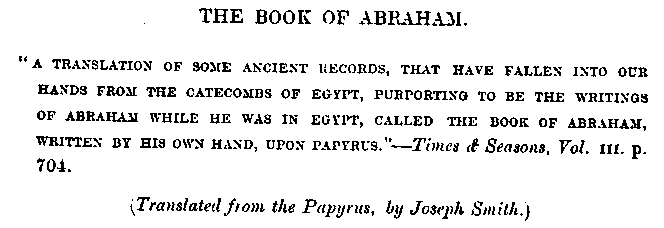
The title of the 1851 edition of the Book of Abraham reads:

The title of the 1921 (present) edition of the Book of Abraham reads:

The reference has been changed to a more readily available document. "Purporting to be" has been removed, making the identification sound definite. The versions are in agreement that the entire book has been translated by Joseph Smith from a papyrus source.
The three figures in the Book of Abraham indeed contain Egyptian hieroglyphics symbols, as would be expected from Egyptian papyrus documents. Joseph Smith describes the meanings of the illustrations and the wordings in the Book of Abraham. Furthermore, Joseph Smith wrote his translation effort in a notebook, "Egyptian Alphabet & Grammar" which is available on microfilm. On those pages with Book of Abraham material there is a left hand column containing the papyrus symbols and the rest of the page with the translation. There are two versions of chapter 1 and part of chapter 2 in this notebook.
The original papyrus was thought lost in the great Chicago fire. However, some fragments were discovered in the Metropolitan Museum of Art, New York, and presented to the Mormon Church in November 1967. Independent translations of the papyrii were made by numerous Mormon and non-Mormon scholars.
Note that the news had not reached Joseph Smith of the Rosetta Stone discovery that gave the ability to translate the Egyptian hieroglyphics.
Back, Next
Intro,
Book of Abraham,
Creation,
Origin,
Papyrus,
Meanings,
Facsimile-1,
Facsimile-2,
Facsimile-3,
other errors,
summary